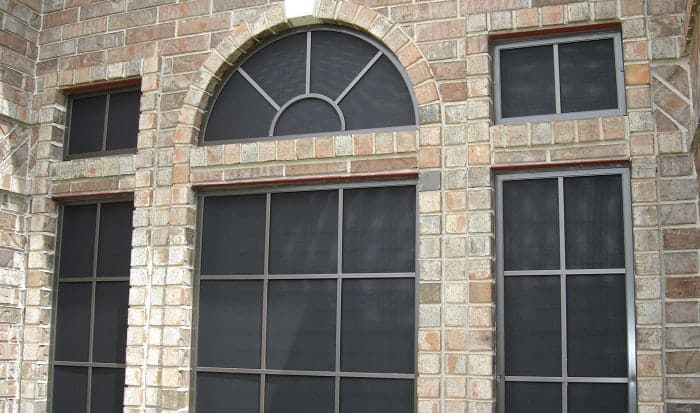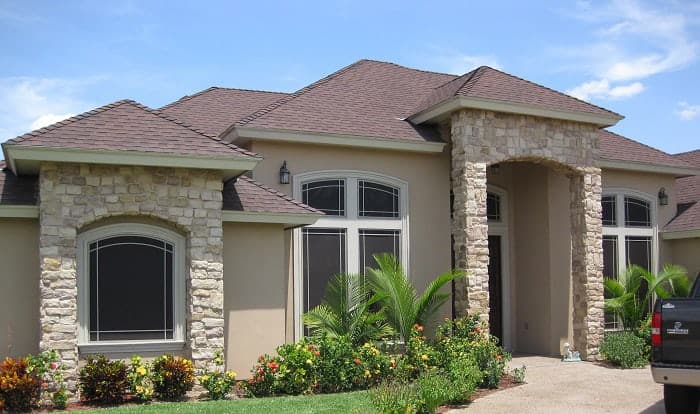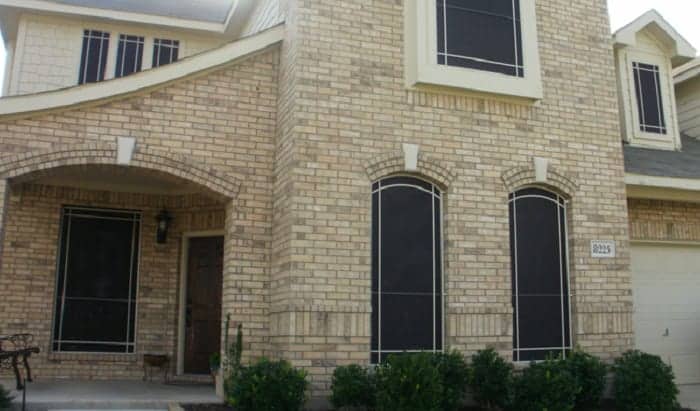Table of Contents
- What are Solar Screens
- Where to Utilize Solar Screens in Your Home
- Will You Hire a Contractor or Opt for a DIY Installation
- How Much Do Solar Screens Cost
- What are the Factors that Affect Solar Window Screens Cost
- How Much Will It Cost You to Replace Your Solar Screens
- Types of Screens to Select From
- The Upsides and Downsides of Installing Solar Screens at Home
- Which One is Better: Installing Solar Screens or Window Tinting
- Conclusion
Solar screens serve a vital role in reducing your electricity costs, mainly if you reside in a sunny and warm climate. They are ideal for minimizing the amount of sunlight that enters your dwelling place and making it properly insulated and naturally cooler.
How much do solar screens cost at present? In general, the price of solar screens can differ broadly depending on several factors, but the common range is $120 to $480 per door/window.
You need to consider your current location, how many windows you have in your home, the size of your windows, and the materials used.
In this post, we’ll look into the several factors we need to think through before making the final buying decision.
What are Solar Screens
Solar screens are similar to other types of screens that lessen glare and sunlight at home. They are primarily used for blocking UV rays and direct sunlight in your place. You affix them to your windows from the outside.
Installing solar screens may take roughly a couple of hours. They offer distinct ranges of privacy and light filtering. The good news is that research revealed that solar screens work exceptionally in lessening electric expenses up to 33%.
Exterior solar window screens are generally manufactured using a durable mesh material that is foldable like fabric; however, they could act like plastic. Each mesh screen is designed with holes. The sizes of the holes are distinct and dictate their openness.
Where to Utilize Solar Screens in Your Home
It’s critical to utilize your solar screens in locations ideal for this type of window treatment to make the most out of them. Any place that takes in ample sunlight will be the best spot for solar screens.
Most homeowners decide to place their solar screens on south-facing windows. This is because those spots collect most of the morning light and the most sunshine all through the day.
More importantly, solar screens work like a charm in ensuring privacy when utilized on bathroom windows. In the same way, they help provide privacy in large living or sitting rooms without entirely obstructing outside views.
Did you know that aside from using solar screens on nearly all types of windows, you can also use them for sliding doors, French doors, or glass patio doors?
Will You Hire a Contractor or Opt for a DIY Installation
With the aid of the right tools and some practical DIY experiences, you can assemble your own solar screens. Notwithstanding, allowing the professionals to do the job can ensure premium insulation and a smoother fit.
Before installing or buying solar screens, carefully check if you can affix them inside of the window’s recess or on top of the frame itself. If possible, assembling solar screens inside the window’s recess is better as it inhibits the most sunlight and looks more incredible.
How Much Do Solar Screens Cost
Often, it’s challenging to come up with a precise average, given the labor rates for professional window contractors, the broad array of solar shades, screens, door and window sizes.
Nevertheless, the total cost of solar screens for countless solar screen projects generally ranges from $120 to $480 per door or window. The cost of solar screens averages approximately $8 per square foot.
On average, the solar screens cost per window is $300; note that this price already includes labor costs. It is also pricier if you have specific density or openness levels and custom screens. Moreover, your total solar screen expenses will mostly come down to your door or window size or if you decide to hire a professional to do the project.
It’s worth noting that solar screens crafted from sturdier mesh are priced higher. They come in several different colors. Darker screens are ideal for effortlessly seeing out your door or window. Meanwhile, lighter screen colors are adept at bringing in more natural light.
As for the price, there is no considerable difference between lighter and darker options.
What are the Factors that Affect Solar Window Screens Cost
As previously mentioned, several factors could increase or reduce the cost of solar screens. While it’s true that it’s impossible to control all exterior solar shades cost factors, it’s helpful to keep the following under control:
1. Professional Installation
Sure thing, this will add considerably to the final cost. Regardless, it can guarantee better insulation and a smoother fit.
2. The Size of the Solar Screen
Solar screens specifically made for doors are undoubtedly pricier compared to standard-sized window screens.
3. Openness
Some sellers charge more for low openness since it calls for more raw materials overall during the manufacturing process.
4. Custom-made Solar Screens
You can expect that custom-made solar screens are the costliest versions sold on the market. Since they are handcrafted, it isn’t surprising that they come with higher price tags.
How Much Will It Cost You to Replace Your Solar Screens
You might have different reasons for replacing your solar screens; probably, you wish to upgrade your present screens to more durable and excellent alternatives.
If your screens are already worn out, or you’d like to shift from fiberglass to stainless steel material, then you’ll need a replacement.
Regardless, the expense to replace your old solar screens generally varies depending on the solar screen itself and where it is positioned.
Generally speaking, you spend roughly $30 to $300 per window for the replacement since worn-out screens must be removed and discarded before you install the new ones.
Take into account that the cost is primarily influenced by the size of your window, the type of screen, and whether any custom screen work is necessary.
Should you wish to learn how to replace your window screens, you may check out this video:
Types of Screens to Select From
You can select from several different types of screens. Each of them is designed using different materials as well as styles. Some of the most popular screen types include:
1. Roman Shades
These screen types are crafted using thicker fabric materials. You can hang them neatly.
2. Roller Shades
You can pull them up or down to allow varying amounts of sunlight.
3. Solar Shades
These versions provide you with a clear view outside without allowing direct sunlight or UV rays to enter your place.
4. Honeycomb Shades
These options resemble blinds and are outstanding alternatives for homeowners who prefer the contemporary style.
The Upsides and Downsides of Installing Solar Screens at Home
Before you invest in something, of course, the first thing that you must do is weigh the pros and cons. Since solar screens are expensive investments, you need to mull over whether they are suitable options.
There are many different reasons homeowners pick solar screens over other types of window treatment. Let us explore the advantages and disadvantages of installing solar screens to help you decide whether they are for you or not.
Upsides:
- Significantly help minimize electricity bills
- Provide better insulation
- Help protect interior equipment and furnishings
- Ensure excellent UV absorption
- Offer more privacy for homeowners
- Keep the home cooler during the scorching summer
Downsides:
- Pricey installation costs
- Costlier options than regular screens
- Can block your views
- Expensive and challenging to clean
There’s no denying that solar screens are priced higher than conventional curtains or solar blinds. The assembly process is pricier compared to installing other types of window treatments. On average, $168 is the cost to install a window treatment, with many homeowners paying between $102 and $159.
Regardless, the upsides overshadow the downsides.
Which One is Better: Installing Solar Screens or Window Tinting
Solar screens are more excellent at blocking and absorbing UV rays coming from the sun than window tinting. Unquestionably, window tinting does a great job of obstructing the sun’s rays; however, they are incapable of absorbing heat very effectively.
While it’s true that window tinting could somewhat minimize the heat in your place, they are not as effective as solar screens. Furthermore, window tinting serves as a permanent window treatment; on the other hand, you can roll up solar shades to delight in outdoor views.
Conclusion
In a nutshell, solar screens are a worthwhile addition to any home, especially for homeowners searching for a little less sunlight. They are also reliable in saving energy and allowing you to enjoy more privacy. While there are a few potential setbacks in installing one, the pros outweigh the cons.
We want to remind you of the following vital points on how much do solar screens cost. Costs vary depending on factors like:
- Professional installation and size of solar screens
- Your location’s openness
- Custom-made solar screens or materials used
While solar screens can be costly, they can ensure remarkable economic significance as your yearly savings on utility bills will dramatically increase.

I am Kathleen Miller, staff writer and reviewer of the Avasolar team. Working with the team has been a pleasure for me so far, I hope to bring readers useful information by creating detailed and easy-to-follow contents.



